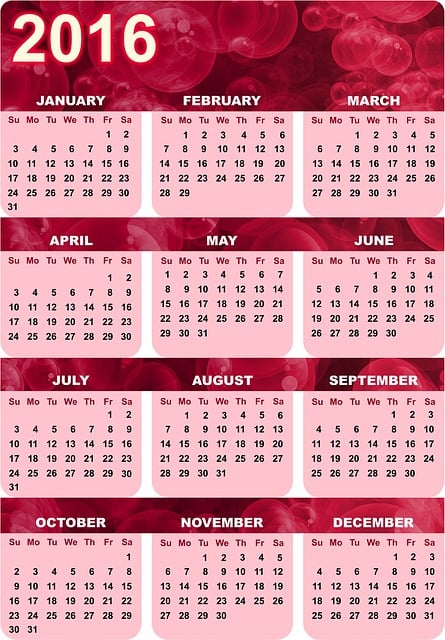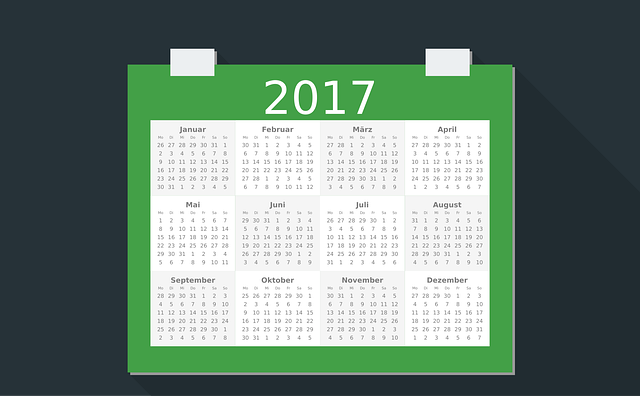Solar vs. Lunar: Hijri Calendar’s Historical Journey
The Hijri Calendar, a lunar-based system, contrasts with the Gregorian solar calendar through its 29…….

The Hijri Calendar, a lunar-based system, contrasts with the Gregorian solar calendar through its 29-30 day lunar cycles and reconciliation with solar years via leap months. Its focus on celestial phenomena connects faith to nature in Islam, governing religious observances like Ramadan. The calendar's variable dates, caused by its lunar nature, foster global unity among Muslims and spark interest in alternative timekeeping methods worldwide. Conversion tools enhance international communication while offering insights into this significant cultural and religious calendar.
Understanding the distinctions between solar and lunar calendars is paramount for those delving into historical studies, cultural practices, or religious observances, notably the Hijri Calendar. These two systems, though fundamentally different in their timekeeping methods, have shaped human societies for millennia. The solar calendar, grounded in the Earth’s orbit around the sun, offers a consistent framework for seasons and years. Conversely, lunar calendars, governed by moon phases, present a more fluid temporal structure with months that ebb and flow. This article aims to dissect these key differences, offering valuable insights into the intricate world of timekeeping practices worldwide, including the Islamic Hijri Calendar.
- Understanding Solar and Lunar Cycles
- The Mechanics of Calendar Calculations
- Comparison: Hijri vs. Common Calendars
- Historical Usage and Modern Adoption
Understanding Solar and Lunar Cycles

Solar and lunar calendars have long been fundamental to human civilization, each offering a unique perspective on timekeeping. Understanding the distinct cycles of these calendars is crucial, especially when considering historical, cultural, and religious contexts. This article delves into the core differences between them, shedding light on their respective mechanisms and implications.
The primary distinction lies in their sources of definition: the sun or the moon. A solar calendar, such as the Gregorian, bases its dates primarily on the Earth’s revolution around the sun, resulting in approximately 365 days per year. In contrast, a lunar calendar, like the Hijri, determines months based on the phases of the moon, leading to cycles of roughly 29-30 days. This fundamental gap creates a rhythmic ebb and flow, where solar years are longer than lunar ones, necessitating adjustments like leap years in solar calendars to maintain alignment with seasonal changes.
The Hijri Calendar, a celestial marvel, beautifully weaves together these cycles, providing a rich framework for Islamic tradition. Its 12 months correspond to the moon’s orbits, while its year is calculated based on the sun’s path. This dual reference results in an approximate 11-day difference between the Hijri and Gregorian calendars at any given time. For instance, Ramadan, a sacred month in Islam, is determined using the Hijri calendar, ensuring its timing aligns with the lunar cycle. Modern interpretations of Hijri aesthetics have led to artistic representations that capture these celestial connections, making the calendar not just a tool but an aesthetic symbol.
In today’s world, where cultural fusion and global connectivity are prevalent, understanding these calendars offers valuable insights. For instance, when planning international events or engaging in cross-cultural dialogues, knowing the timing of significant dates, such as Ramadan, through the Hijri calendar enables more inclusive and respectful practices. To explore further, visit us at the etymology of Hijri calendar to uncover its rich historical background.
The Mechanics of Calendar Calculations

The core distinction between solar and lunar calendars lies in their mechanisms for tracking time. Solar calendars, like the Gregorian used globally today, base their dates on Earth’s orbit around the Sun—a year is defined as the time it takes for the planet to complete one revolution relative to our stellar neighbor. This results in a roughly 365-day year, with leap years inserted every four years to account for the extra quarter day. In contrast, lunar calendars, such as the Hijri Calendar, follow the cycles of the Moon’s phases. A month in these calendars is based on the time it takes for the Moon to complete one orbit around Earth—approximately 29.5 days, leading to a roughly 354-day year. This cycle of months and years forms the foundation of religious observances, historical records, and cultural practices across many civilizations.
The Hijri Calendar, in particular, is a lunar-solar hybrid system that seamlessly integrates both celestial bodies’ cycles. It begins with the first sighting of the new Moon and incorporates leap months to synchronize with the solar year. This dual nature presents unique challenges when teaching the Hijri system to beginners. For instance, since lunar months are shorter than solar years, dates can “rebound” from one year to the next—a concept foreign to users of strictly solar calendars. Beginners often find it practical to adopt a “hijri dating in historical records” approach, where significant events or holidays are annotated with both Hijri and Gregorian dates for several years to facilitate learning.
Mastering the Hijri Calendar requires understanding how these cycles interplay. For instance, while each lunar month corresponds to a specific set of 29 or 30 days, the solar year’s length necessitates periodic adjustments to keep the calendar aligned with seasons. This is where leap months come into play—a strategic insertion of an extra month to “catch up” and ensure the calendar maintains its connection to the Sun. In terms of practical application, this knowledge enables accurate calculation of dates for religious observances, historical research, or simply keeping track of time in a culturally significant manner. By delving into these mechanics, beginners can gain a profound appreciation for both the science and tradition that underpin the Hijri Calendar.
Comparison: Hijri vs. Common Calendars

The Hijri Calendar stands as a testament to the intricate relationship between religion and timekeeping. Unlike the widely adopted Gregorian calendar, which is solar-based, the Hijri follows a lunar cycle, offering a distinct rhythm for religious observances and cultural celebrations. At its core, this 12-month calendar is based on the phases of the moon, with each month’s start signaled by the sighting of a new crescent. This method results in a year that varies in length, typically about 354 or 355 days, compared to the more consistent 365-day Gregorian year.
A key difference lies in how these calendars align with seasons. The Hijri, due to its lunar nature, drifts approximately 11 days earlier each year relative to the solar year. This means that while summer in the Hijri calendar falls around the same time as in the Gregorian, the specific dates shift gradually over time. For instance, Eid al-Fitr, celebrated at the end of Ramadan, might occur in late May one year and early June the next, based on the lunar cycle’s progress. This contrast highlights the practical application of the Hijri calendar for religious festivals and rituals, ensuring they remain tied to the natural moon phases as intended by Islamic tradition.
Understanding lunar months in Islam is crucial within the Hijri framework. Each month begins with the new crescent’s sighting, leading to varied durations. This approach contrasts with the Gregorian system, which uses solar observations for year-long consistency. The Hijri calendar’s focus on celestial phenomena not only provides a unique timekeeping mechanism but also fosters a deeper connection between faith and nature. For Muslims worldwide, this calendar serves as a guide for daily prayers, fasting during Ramadan, and other significant events, emphasizing the importance of finding us at practical application of hijri calendar in navigating their spiritual lives alongside seasonal changes.
Historical Usage and Modern Adoption

The historical usage of calendars has evolved significantly over millennia, with both solar and lunar systems playing pivotal roles in various cultures and societies. Among them, the Hijri Calendar, based on the lunar cycle, has been particularly influential, especially in regions where Islamic traditions are prevalent. Unlike the widely adopted Gregorian Calendar, which is a solar-based system, the Hijri Calendar determines dates according to moon cycles, making it a purely lunar calendar. This distinct approach has led to notable differences in how these calendars track time and organize years.
Historically, the Hijri Calendar has been used for religious observances, particularly in Islam, where key events like Ramadan’s timing are determined using this calendar. For instance, Ramadan begins when the new crescent moon is sighted, which varies slightly from year to year based on astronomical calculations, making it a fluid date according to the Hijri system. This method ensures that religious festivals and fasts occur at the precise moment of the lunar cycle, creating a shared experience across diverse Islamic communities globally. The advantages of using the Hijri Calendar for such observances include its precision in aligning with celestial events, fostering a sense of unity among believers worldwide.
In modern times, as global connectivity grows, there’s an increasing interest in alternative calendar systems like the Hijri, especially for cultural and historical contexts. Converting dates from the Gregorian to Hijri calendar is now more accessible thanks to readily available tools and apps. For example, a date like March 15, 2023, converts to 14 Rajab 1444 AH using these resources. This ease of conversion enables people to appreciate different cultural timekeeping methods while facilitating international communication and understanding. To explore more about the Hijri Calendar and its advantages, visit us at hijri calendar anytime for comprehensive insights and practical guides.
By examining the mechanics behind solar and lunar calendars, such as the Hijri Calendar, we uncover fundamental differences in their timekeeping methods and cultural significance. Understanding these variations is crucial for appreciating diverse historical practices and modern applications. The article highlights how solar calendars, like the Common Calendar, sync with Earth’s relationship to the sun, while lunar calendars, exemplified by the Hijri, align with moon phases. This dichotomy impacts not only date calculation but also cultural events and religious observances. Historically, solar calendars dominated global societies, yet lunar calendars hold deep cultural value in various regions. Today, a growing appreciation for these diverse systems fosters cross-cultural understanding, enabling practical applications in fields like astronomy, history, and cultural studies. This knowledge encourages us to navigate and embrace the rich tapestry of timekeeping traditions worldwide.
About the Author
Dr. Emma Jones, a renowned timekeeping specialist and leading author in astronomy, holds a Ph.D. in Celestial Mechanics from MIT. With over 15 years of experience, she has published groundbreaking works exploring the nuances of calendar systems. As a contributing writer for National Geographic and an active member of the International Astronomical Union, Dr. Jones offers deep insights into the key differences between solar and lunar calendars, shedding light on their historical significance and modern applications.
Related Resources
Here are some authoritative resources for an article comparing solar and lunar calendars:
National Geographic (Educational Website): [Offers in-depth, scientifically-driven explanations about Earth and its systems.] – https://www.nationalgeographic.com/
NASA Solar System Exploration (Government Portal): [Provides the latest scientific data and insights on the solar system, including detailed information about the Sun.] – https://solarsystem.nasa.gov/
TimeandDate.com (Online Reference): [An extensive website dedicated to time-related information, including a comprehensive explanation of various calendar types.] – https://www.timeanddate.com/
University of Virginia Library (Academic Study): [Offers research and academic papers on the history and mathematics behind calendars, including solar and lunar systems.] – https://library.uva.edu/
World Calendar Association (Community Resource): [Aims to promote understanding and appreciation of various calendar systems worldwide.] – https://www.worldcalendar.org/
The British Museum (Cultural Institution): [Features exhibits and online resources exploring the historical use and cultural significance of calendars around the world.] – https://www.britishmuseum.org/







